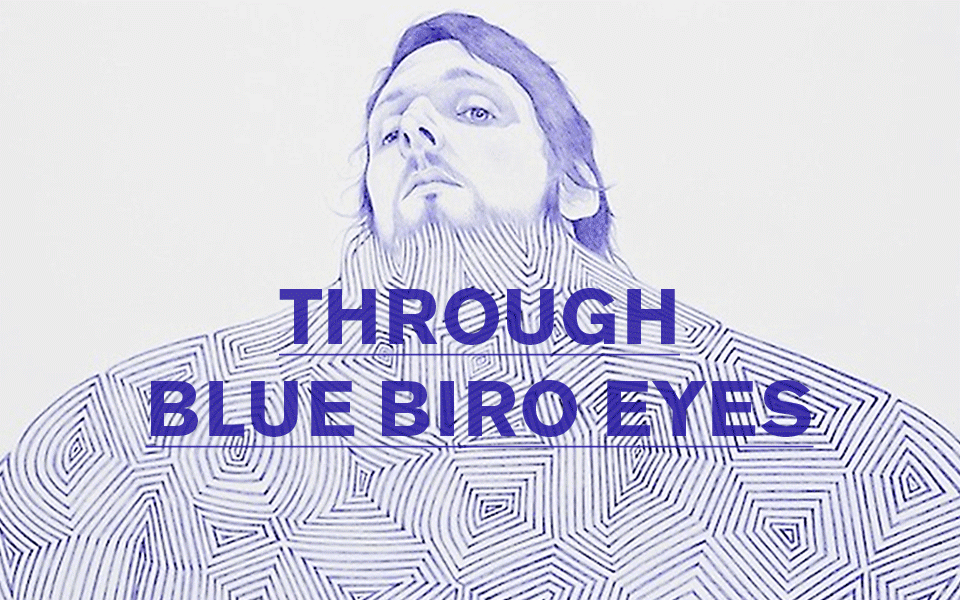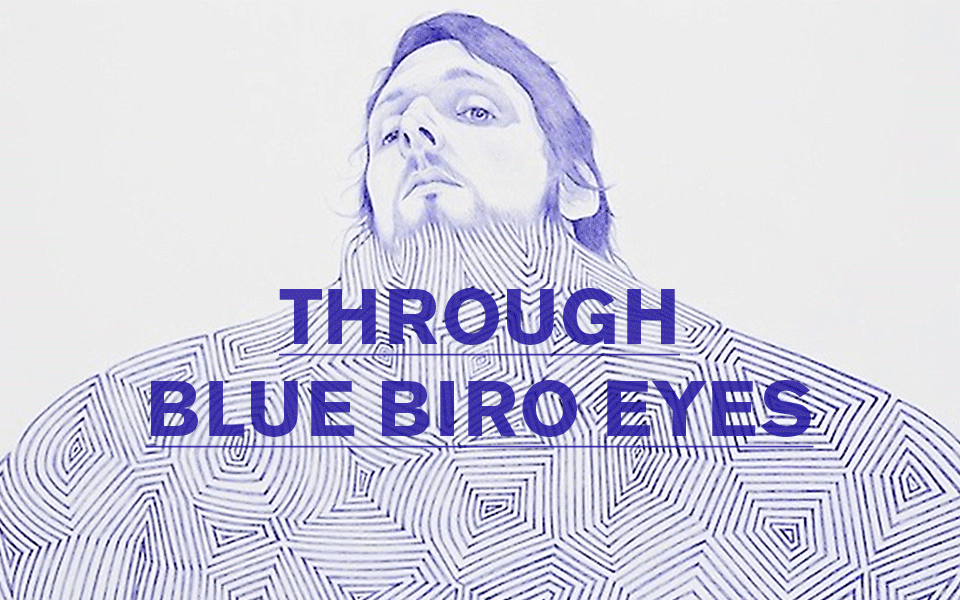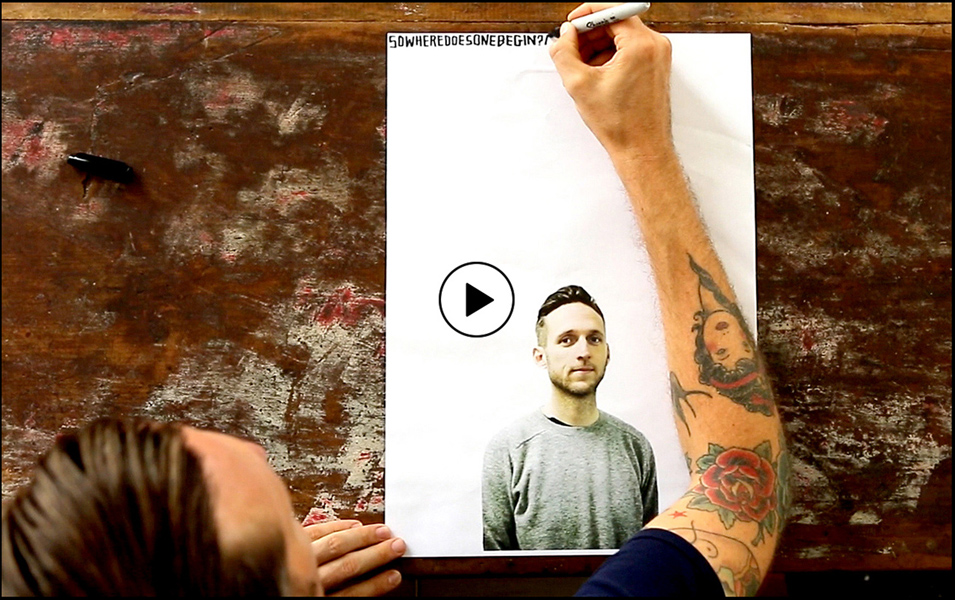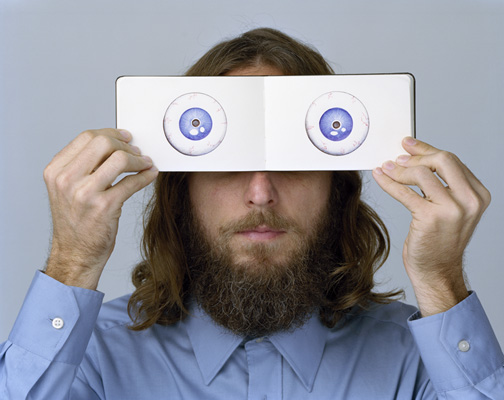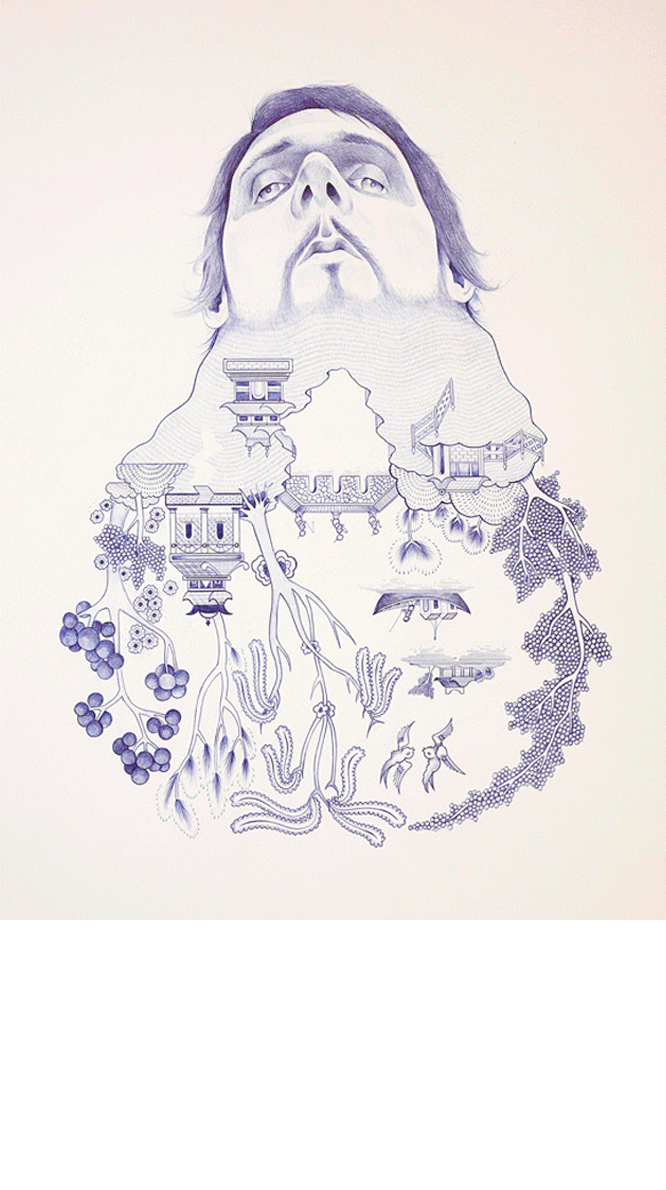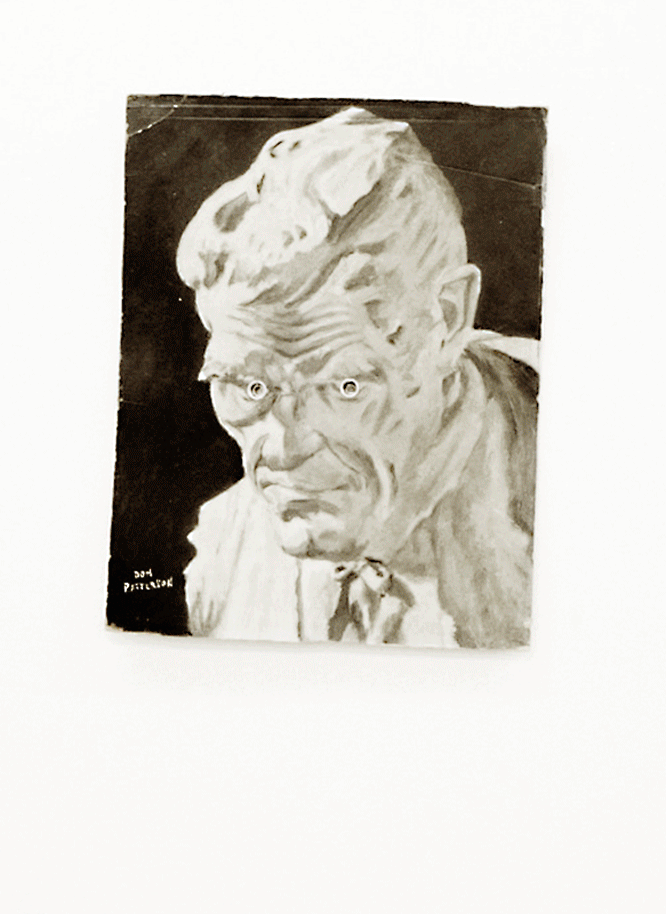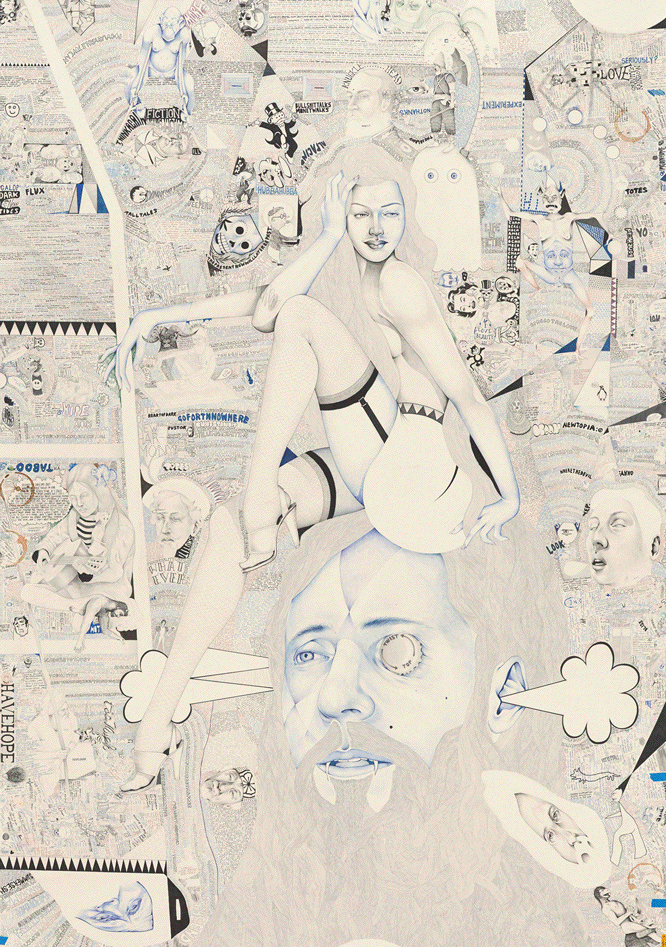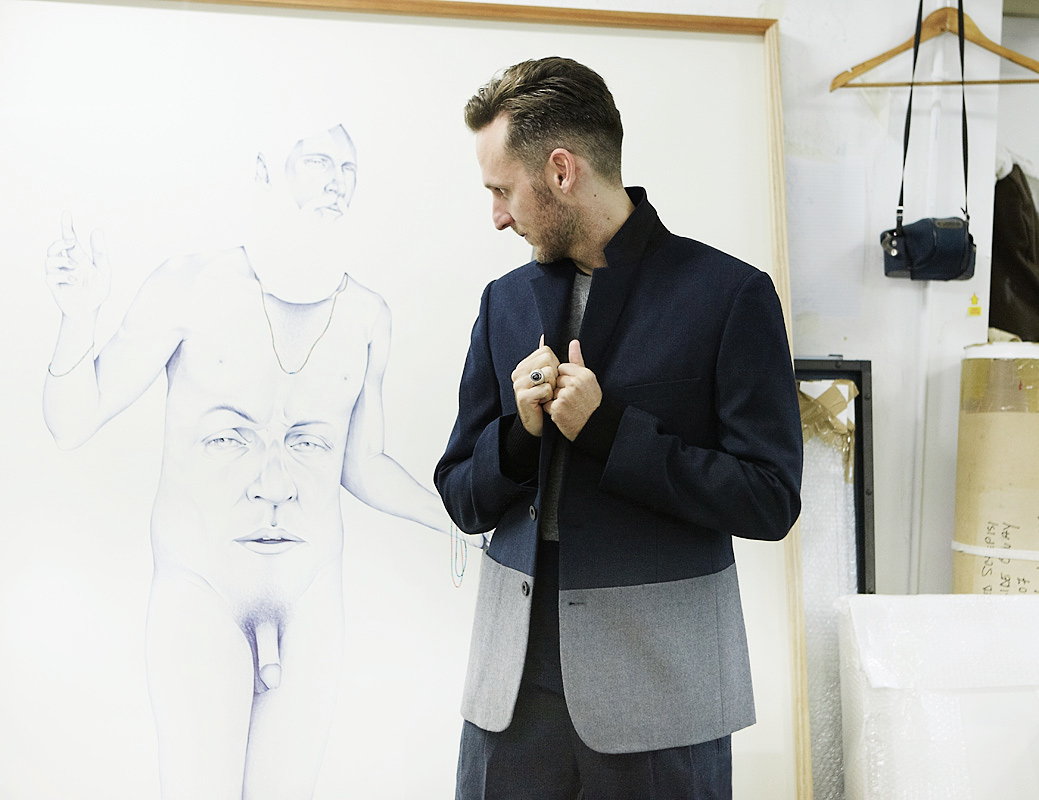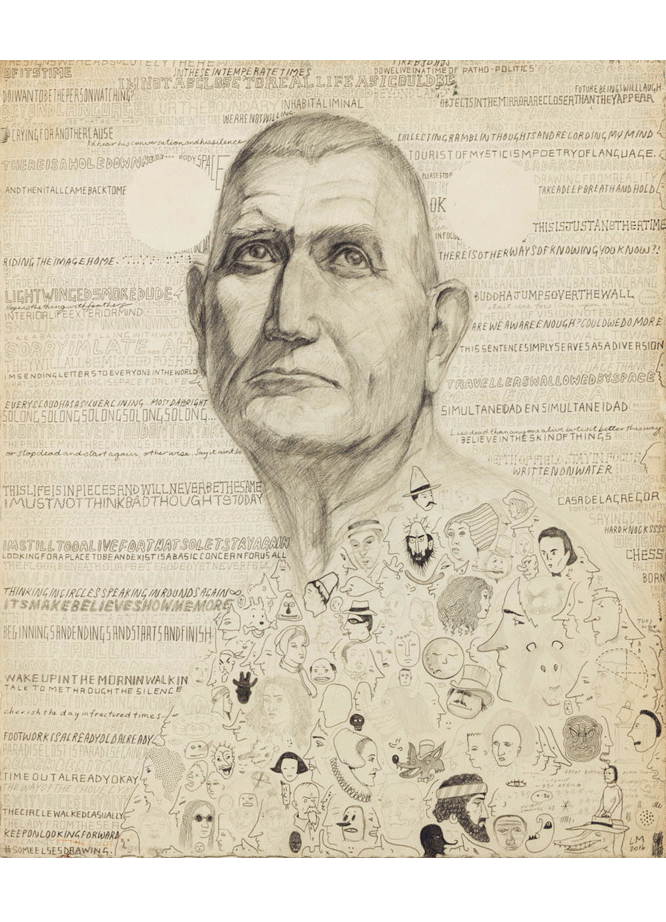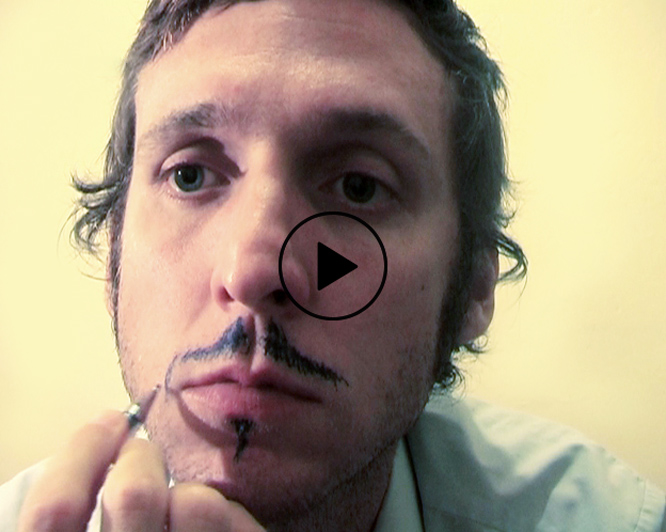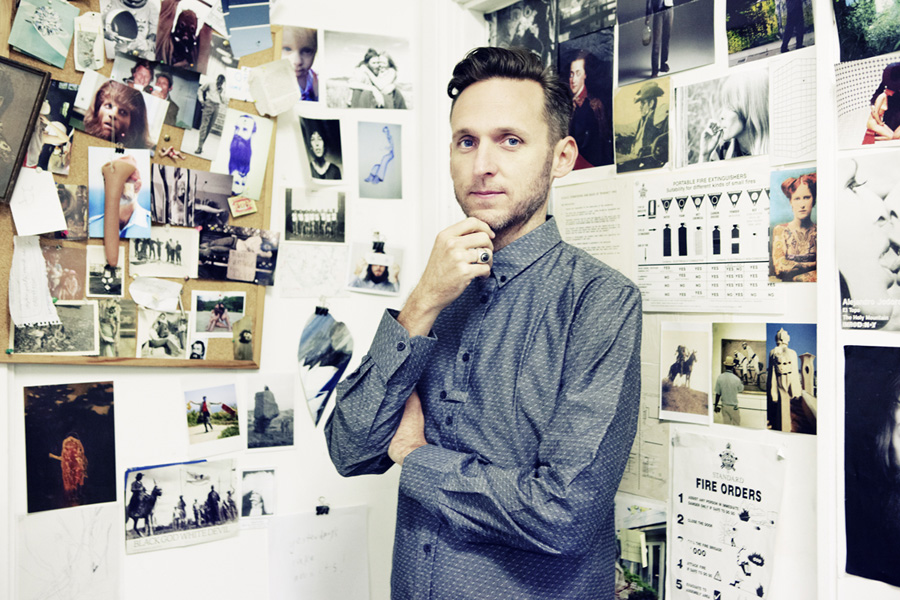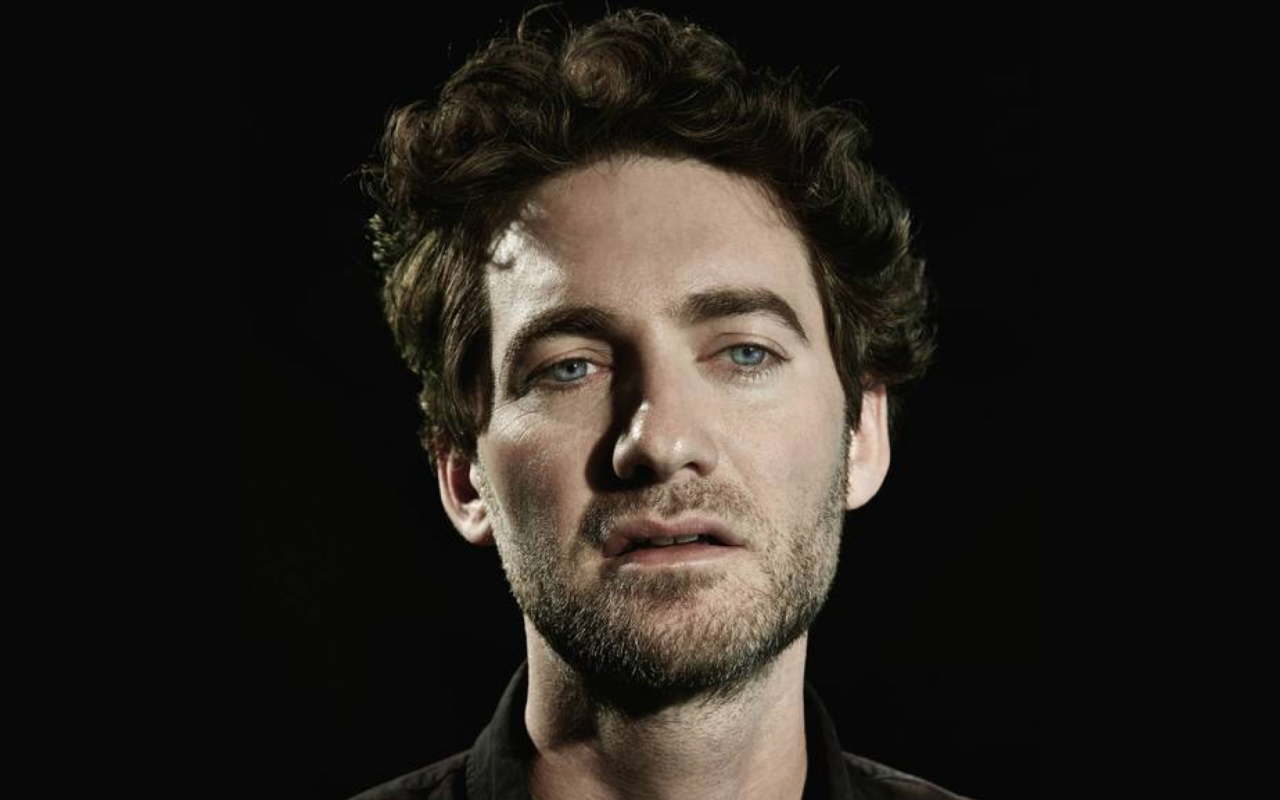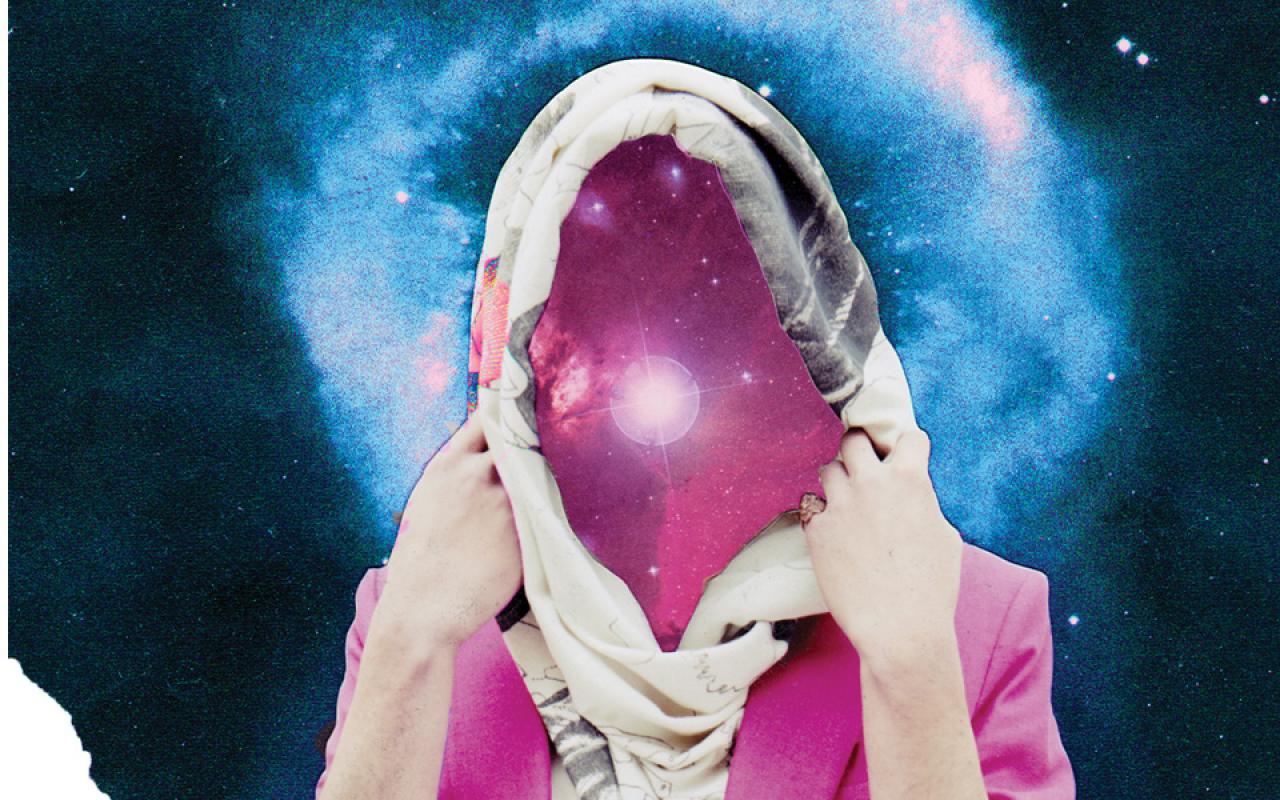profile \ 02
Laith McGregor
Artist
SO WHERE DOES ONE BEGIN
WITH HINDSIGHT
Text by Amanda Austin
Made bold by his biro, artist Laith McGregor seems to entomb a little of himself in everything he creates. Whatever artwork of Laith's you look at, he is somehow always there, emanating from behind whatever medium is being used to convey his thoughts, feelings, and ideas. Or literally, there he is, staring right back at you - with those perfectly crafted blue biro eyes.
BABY BLUES
Looking back over the career of artist Laith McGregor, you can see as much of what sets his work apart as you can the threads that emerge and run throughout and tie it all together. Following Laith's work back to its first public showing, it was his unique biro works, mainly portraits, that initially exposed his work to a wider audience and propelled him early on into a notable emerging artist, and 'one to watch' within the contemporary Australian art scene.
It was during Laith's time at art school that the original perspective and talent of this young artist had people starting to take notice. Finishing his Bachelor of Fine Art (Hons) at Melbourne's Victorian College of the Arts, in 2007, Laith was already well on his way to exhibiting his first defined body of work.
By 2011 Laith had won the Robert Jacks Drawing Prize (2008), The Qantas Foundation Encouragement of Australian Contemporary Art Award (2009), the Emerging New Work Grant by The Australia Council for the Arts (2009) and was named as a finalist for a ream of other prizes. He had received a New Work Grant and carried out a residency at the Centre Intermondes, in La Rochelle, France and in 2011 he received another New Work Grant and undertook a residency in Barcelona. Not bad for an artist still technically in his ”emerging" years - largely using the humble ballpoint pen.
YOUNG
I met Laith through my long time close friend and his now-wife Kylee. They both came to Sydney in 2008 to visit for Laith's first group show represented under Sullivan and Strumpf Gallery, in Paddington. We had lunch ealier in the day of the exhibition opening to catch up. During our conversation arose the debate which had continued to surround his choice to largely use, what was seen as; the 'commonplace' blue biro. In the last years at art school Laith's use of the ballpoint, for some of his major works, became a central conversation when his work was discussed, and throughout his final assesments it came to had come to light that some of Laith’s teachers and critics openly opposed it - some going as far as viewing the use of pen on paper, in fine art, as a degradation of artful practice. At lunch that day, Laith mentioned in passing that one of the artists he would be showing alongside that night was a teacher from art school, who of course knew firsthand how widely contested and debated Laith's decided use of the lowly ballpoint pen was.
When arriving at the gallery later that night for the opening I was surprised and warmed to see that it was Laith's work, Young, that was holding pride of place and hanging in the gallery's front window. The artwork was a large, immaculately detailed, photo-realistic portrait of a man, drawn solely in blue ballpoint pen, with a huge, billowing, blue beard and inside of this giant beard were the words taken from the line of a Neil Young song - "Old man take a look at my life, I'm a lot like you."
It was that particular piece which hung impressively illuminated as the opener of the show, as well as the pieces he chose to follow it in this first exhibition with Sullivan and Strumpf, that gave me my first insight and that warmed me very quickly to the work of Laith McGregor. I couldn't help but smile at the relevance of that particular piece hanging in the front window, quietly showing the art world that his practice and his $2 pen, had just as equal footing within the world of fine art as any traditionalist. My smile inside possibly doubled by my Australian tendency to find satisfaction in the underdog coming out on top, against the odds - but his collection of work stood for, and stood out for, its own unique and clear perspective; the work held a confident childlike audacity, just naturally and unaplogetically himself, saying something. As I passed the window and entered the gallery, I couldn't help but smile wide for it all.
EYE / I
Some stage after the Sydney show, Laith received a residency at Gertrude Contemporary, Melbourne. Alongside the workspace studio he received an empty gallery space, within the building, to exhibit his work at free will throught his residency. Visiting Laith at this space when I photographed him for this article, he mentioned that he had recently installed a piece in the gallery space, that he would leave hanging for the first month of his residency.
When I left his studio and out into an old labiryth of a building, I thought I had gotten a little lost. The space he had given me directions to was basically empty - aside from what seemed like from far off, an one old, buckled canvas with a white on black portrait of a man's face - which I did not initially recognise as Laith’s work. After searching around the other rooms with no luck, I returned to the original, seemingly empty space, to take another look at this one 'simple' portrait hanging on the far wall of the gallery. When I got a little closer I noticed there were 2 indented circles within the eyes of the roughly painted face. A closer look revealed 2 barrels, or portals, of transparent glass in place of the man's eyes.
I got up close and put my eyes level with the eyes of the man in the painting and through the glass barrels, and was surprised to be looking directly into Laith's working studio and at my friends chatting in the corner, in real time. It was a peep show through the eyes of the painted man. Anyone could come anytime and just watch Laith drawing away and at all the entire inner workings and processes of his artwork in progress. This one unassuming, old buckled portrait in the corner of a white space was his piece of choice. It what he wanted to say and the conceptual summation of all he was working on and towards: "Welcome to me." "Come on in." it seemed to say, in a very peculiar way.
In this personal space Laith had created a seemingly simple installation that transferred a concise, yet complex understanding of the thread that travels throughout all of his work: Himself. Un-edited. There he was, in his own little world, churning and burning through paper, pens, and thoughts as he mentally digests life, culture, history, and himself in amongst it all, as it swirls around him like one of his many diary-like montages, and he is always somehow, somewhere in there, as the centerpoint or counterpoint to it all. Those two little glass eyes, through a rough painted face, contained the ability for me to understand a lot about Laith's objective through his work, in one neat, singular letter: I.
This candid discovery of yourself through art and creative expression, exposing the viewer to an unedited day-to-day flow of thoughts, ideas, and experiences, -if done with real honesty and authenticity, not only helps the work to build a direct connection with its audience, but it creates an added layer to the work. This added layer is an invitation to consider the artist behind the material as an addition to the work, or as an extended passage to understanding their work more deeply, and as a whole. Using the self as a central concept, in art and expression, naturally helps the work to always change and evolve. The complex tapestry of trying to understand the world as we mature, experience. and grow is very evident in Laith's overall body of work. Laith's process of exposing himself and his inner world, unedited, leads the audience to take an interest in Laith McGregor, the man behind the art, as a way of understanding the living and ever-evolving context of it the work as a whole, at some stage, however long into the future, his life will be there, emating life as it was on someboy's wall somewhere.
PING PONG PARADISE
Much of Laith's work contains a direct and personal exchange with his audience, this can be seen most clearly through his series of illustrated Ping Pong Tables. One of the tables: Gnip Gnop, was shown at MONA in Tasmania, 2013, and remains as part of owner David Walsh’s personal collection. The first in the series: Ping Pong Paradise (2012,) was purchased pre-show by actor Orlando Bloom and is said to reside in his Los Angeles home. These functioning, life-size ping pong tables are covered in what was sometimes year-long vestiges of thoughts, conversations, doodles, self-portraits, coffee-cup stains, daily to-do's, diary entries, dreams and nightmares; a candid exploration of the inner workings of the artist’s mind in the process of creating his more formed ideas and artworks, completed over time, whilst he ruminated over a game of pong.
The pieces from this series offer a stream of consciousness and direct insight into the artist's mind, not unlike reading excerpts from his personal diary. This process of turning an open display of the artist's journey into an artistic expression, in itself, raises it up as a central consideration, and offers the viewer a deeper understanding of the conceptual backbone of his work. Laith has said that his intentions of Ping Pong Paradise were for the audience to: "Mull over his inner thoughts and engage with the work while playing a light-hearted game of pong." Keeping the audience playing a fun game of ping pong holds them back from taking it all too seriously, focusing more on just what it is: a mere outing of inner dialogue, experiences and an overflow of thoughts from that particular time, contained and framed like a time capsule of his life and personal growth.
When art revolves around self-identity and an intimate perspective, somehow it changes from something personal and unique into something that universally resonates, identifies, and connects us as an audience. Looking at Laith's work in its entirety becomes like looking through his mirror at his own reflection, which naturally changes and shapes over time, and is what creates this sense of Laith entombing himself within his work. Even though his themes and ideas are so particular and personal to him, they are a natural response, and therefore a part of the greater human condition. Laith's natural progression within his work - his natural evolution and perplexed inward exploration towards maturity, is a general journey that all of us must take in our own personal way. You can also see him there physically growing and changing throughout his work over time, entombed within his many self-portraits, staring back at you from a time long since passed.
MASCULINITY
When you start to pull back from his central idea of self and identity, you begin to see some of the other themes that run off from this inward exploration. The repetition of ideas within his work helps to develop greater insight into the complexity and subtlety of thought behind his themes and allows ideas to be explored over time and unpacked in different ways. What is also ever-present in his work is an underlying, yet sharp humour that plays with ideas and keeps it all from getting too serious.
One strong thread you can tie around a lot of Laith's work, particularly his early work, is his wonderfully open conversation with himself about masculinity. It is a theme I find personally warming and interesting to decipher and it has made me smile, and even giggle heartily many times when viewing his works for the first time. This thematic contemplation is particularly evident in his early ballpoint pen stage, where he seems to peel away the layers of his internal musings and deconstructs the notion of just what it means to be a 'man'.
The predominance of great men with firm, robust beards - iconic 'real' men, from Jesus to Ned Kelly, his father and grandfather, astronauts, ancient ships and seafarers, messages in a bottle and big chopper motorcycles - are all a strong nod to the defined masculine connotations of great men, both past and present.
Looking at this early work as an overview you can't help but see an honest reflection and a personal journey of the boy becoming a man; a vulnerable phase of growth so potent in shaping a young man's sense of identity and a time which can easily become the crux of most teenage boys complexity.
Within this particular work, you can’t help but think he might have at one young stage bore the brunt of a common Aussie schoolyard male 'pay-out,' which is so prevalent around the time teenage boys begin to develop facial hair. Verbal digs such as, “That’s not a beard mate, that's bum fluff,” can mortify many an unsure pubescent boy into a fit of inner questioning. This beautifully awkward and important phase of every boy's growth seems etched into much of Laith's portrait work and into all the great men he has sought to represent.
As time progresses there becomes a visible sense of Laith maturing throughout his work and with it a feeling that much of his internal wrestle has been stilled, questions answered and his own sense of manhood somewhat defined. Looking back over all of these great men, with their proud, billowing beards - him in there too - I can’t help but see a cheeky retort to all those schoolyard pay-outs, in quite a deep husky tone - “Now, this is a beard mate."
MATURING
Another great insight that provides a lot of amusement to this interesting puzzle Laith has formed, is the hilariously absurd and quite brave video installation entitled Maturing (2008), which takes a look at the process of maturing, facial hair, and identity.
Here Laith takes the biro on its most personal journey yet: his own face. Sitting squarely in front of the camera lens, alone against a white wall, he begins by taking a good look at himself, in the flip-back screen of the video camera. From there, he proceeds to set his face free and contort into different caricatures and exaggerated emotions associated with the maturing process.
Experimenting with different facial hair you can see Laith physically articulate the maturing process and deconstruct the power he places upon the beard; its connotations, and its ability to shape identity and impact one's sense of self.
I can't help but use another personal story to gain insight into Laith and therefore into his work. It's a side note that I feel demonstrates just how unedited and bravely raw Laith desires his work to be.
His partner Kylee told me this story just as I was about to watch his Maturing video installation at the same first group show at Sullivan and Strumpf. She explained she had come home one day to where she and Laith lived together to find the lounge room door locked shut, which was unusual. After a little while, she could vaguely hear Laith making sounds of some kind behind the locked door to the lounge. She went back to the door and curiously knocked and called his name, but he didn't answer. She kept listening and heard him making really strange sounds and began to imagine all kinds of things, mostly, "are you masturbating?" - Not due to this being a regular occurrence, it just seemed so out of character and secretive. She called his name louder and louder, with this question implied within her tone.
About halfway through the film, Laith's eyes - his face half scribbled over in biro - start to pensively flicker off-screen. He then gets up and abruptly leaves the frame for a few moments, which I then understood was Laith answering Kylee at the door, showing his face and the innocence of what he was doing. When he sits back down into the video frame, he is brightly flushed in the cheeks and has a slightly ruffled, "Where were we?" look on his face, as he continues to take his pen back to work. Slowly you can see the pink flush die down from his cheeks. Most people would have edited this interruption and others, such as getting up to find a new pen and moments of lapsed concentration out of the footage but he leaves the video recording from start to finish, uninterrupted and again, unedited.

OHNE TITEL
From the diverse use of media and mediums in Laith's work so far - video, sculpture, painting, biro drawing and installation - we can understand that his internal wanderings have taken him far and wide.
Moving away from the ballpoint, detailed portraiture and diary work, he went on to create a body of work that even though there are traces of this style in his formative work, it surprised many followers and critics when it was first exhibited. The series, Ohne Titel – Them Listless Folk from Apocryphal was the centre point of his eclectic sold-out show in 2012, which spanned two levels of the new Sullivan and Strumpf Gallery in Alexandria.
The paintings making up the Ohne Titel series, are a wonderfully watery and dreamy oil-on-linen sequence, formed from the awakening of a repetitive childhood dream. These works were starkly divergent from anything else Laith had formerly exhibited.
Laith's early work centered more on a reflection of the world outside of him, but by the time Ohne Titel came about his personal journey seemed to have surpassed the physical and conscious self and led him inward, all the way to the watery shores of his own subconscious.
In this work Laith depicts a character he calls 'Waterface,’ which he chased from the imagination and repetitive dreams of his childhood out onto the canvas. In order to expand and scrutinise the relevance of this figure from his forgotten past, Laith went to the length of undergoing hypnosis to give further shape and detail to what was a faceless man from the depths of his muddied dreams.
The Ohne Titel series is like entering a dark and mystical, out-of-focus dream and feels more of an intuitive exploration of the underbelly of his subconscious rather than a distinct narrative or analysis, as his previous collections had felt.
This diversion from pen to oil paint was a clear and intentional difference from the beards and masculinity series. But it was also the same deep personal line between the viewer and artist that made this series not such a world apart from his previous work, but rather the collection gave his work a new perspective and certain new-found freedom.
The biro exposed a detailed churning of the mind - cheeky, seemingly light-hearted and at times even absurd, but the Waterface series has a striking melancholy to it and pulls you deeper into the depths of Laith's mind. Instead of the intricate detail of his more conscious work, the characters within Ohne Titel lack detail and their painterly tones take on murky, masculine forms wading through the watery, emotive and formless world of his subconscious.
The work is soft, but with it comes something a little unsettling, especially when seeing them large scale and all encompassing and as a collection. I see the faceless men paddling somewhere on an indiscernible background as perhaps signifying a psychological shift and state of flux between his last series to his next.
The tone and overall feeling gained from Ohne Titel is certainly different, but the work gives a strong indication that he had evolved in both his personal and artistic journey. The notion of a subconscious figure wading continually in the unknown, heading toward what is yet to be found, feels like yet another light cast back in at Laith’s own internal processing and progression, and one that feels important in rounding out an overview to his work.
WITH FORESIGHT
Laith McGregor has continued to work religiously since he first began exhibiting and has amassed a body of work that clearly defines the purity of his vision.
To find Laith at the very centre of all of it, no matter what shade, form, or period the work is from, isn't spawned from unchecked narcissism, rather it feels very rooted in a humbling curiosity of all he comes into contact with and everything in life he feels genuinely moved by, its honest and open and inviting.
I find a great deal of honesty within spontaneous gestures and the use of unfiltered expression within the creative process. Not only does it allow the artist to discover something new and unconscious, but gives the viewer greater insight into the artist and feeds the potential for a real and personal connection between the artwork and its audience.
I also believe that spontaneity within a public arena is brave - it rubs against the very nature of human desire to edit, market, and project perfection onto our ourselves and our environment. Within the context of the present world, honest and open articulations of the self from artists such as Laith, become a fresh and welcoming voice in the contemporary arena. His use of himself and the world around him gives his work a real freedom to continue wherever his internal and physical meanderings take him and gives a blank canvas for him to consider and contemplate the evolving world around and inside of him.
I look forward to each series Laith releases and the candid unfolding of his ever-evolving self-portrait. He will undoubtedly be there staring back at me with those deeply penetrating and wonderfully detailed, blue-biro eyes.


